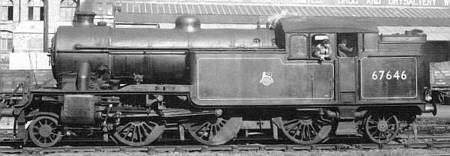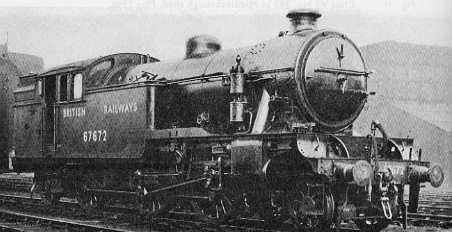The Gresley V1 and V3 2-6-2T Prairie Tank Locomotives

A series of 2-6-2T tank engines was first proposed in 1928 to work the Metropolitan City Widened Lines. The initial drawings featured condensing gear and a short chimney for this work. By late 1928, these features had been discarded. The design was based on the Gresley K1 and incorporated the same boiler. However, Gresley used three cylinders with his conjugated valve gear for the central cylinder. By December 1928, it was decided that the first locomotives would enter service in Scotland. The design continued to evolve, and by April 1929 the K1 boiler had been replaced by a modified D34 Glen boiler. A total of 82 V1s were built between 1930 and 1939 in a total of five batches, although many of the early batches were delayed due to financial constraints.
The leading truck was of the same double-swing link type used on the K3s, and the trailing pony truck was of the N2 radial type. As with North Eastern (NER) practice, the the three cylinders were cast in a monobloc. The inside cylinder was inclined at 1 in 7.96 in order to clear the leading coupled axle. By comparison, the outside cylinders were inclined at 1 in 30.
The superheater was of the Robinson type. This extended out into the smokebox, and cover plates were required. From 1940, ball-jointed elements were fitted, so that the cover plates were no longer required.

With reference to the Middlesbrough-Newcastle workings, in 1936 the North East Area first considered the idea of raising the boiler pressure to 200psi. The first locomotives with this increase in pressure were built in 1939. These were given the class designation V3, and the final batch (built 1939-40) of ten were built to the V3 specification. By Nationalisation in 1948, four of the V1s had been rebuilt as V3s. During BR ownership, a further 67 would be rebuilt as V3s.
The first batch of twenty eight locomotives worked the suburban services around Edinburgh and Glasgow. These had problems during coaling operations, so different types of coal bunker were tried. The original locomotives had a coal rail. This was removed on a number of locomotives, and the eventual solution on later locomotives was to fit a coal hopper.

Over forty of these locomotives would be allocated to the Scottish suburban services. From the mid-1930s, twenty five would be allocated to the North Eastern Area. In the North East Area, they displaced many A8s due to their superior adhesive weight. During World War II, five of the North Eastern V1s were moved to Leeds to help with the increased services to the ROF factory at Thorp Arch. These returned to Tyneside in 1948. After World War II, the Whitby coastal line had its restrictions eased. This enabled the V1s to work this difficult line which they handled particularly well.
The largest allocation south of Leeds, were fifteen locomotives allocated to the Great Eastern Section. Most of these were based at Stratford, but three were allocated to Norwich, and two were allocated at King's Lynn. In 1948, Thompson L1s replaced the Stratford V1s. These were moved to the Scottish and North Eastern Sections.
Withdrawal of the remaining V1s started in 1960, and the class became extinct in 1962. The V3s became extinct in 1964. Most of the V1s and V3s were replaced by diesel railcars. Some were transferred to working parcel trains and empty trains, and were eventually replaced by Type 2 diesel-electric locomotives.
Technical Details
The hopper-type bunker expanded the coal capacity to 4 tons 10 cwt.
| V1 | V3 | ||
| Cylinders (x3): | 16x26in. | 16x26in. | |
| Motion: | Outside: | Walschaerts | Walschaerts |
| Inside: | Gresley | Gresley | |
| Valves: | 8in piston | 8in piston | |
| Boiler: | Max. Diameter: | 5ft | 5ft |
| Pressure: | 180psi | 200psi | |
| Diagram No.: | 102 | 102HP | |
| Heating Surface: | Total: | 1609 sq.ft. | 1609 sq.ft. |
| Firebox: | 127 sq.ft. | 127 sq.ft. | |
| Superheater: | 284 sq.ft. | 284 sq.ft. | |
| Tubes: | 830 sq.ft. (149x 1.75in dia.) | 830 sq.ft. (149x 1.75in dia.) | |
| Flues: | 368 sq.ft. (22x 5.25in dia.) | 368 sq.ft. (22x 5.25in dia.) | |
| Grate Area: | 22.08 sq.ft. | 22.08 sq.ft. | |
| Wheels: | Leading: | 3ft 2in | 3ft 2in |
| Coupled: | 5ft 8in | 5ft 8in | |
| Trailing: | 3ft 8in | 3ft 8in | |
| Tractive Effort: | (@ 85%) | 22,464lb | 24,960lb |
| Total Wheelbase: | 32ft 3in | 32ft 3in | |
| Engine Weight: | (full) | 57 tons 1cwt | 59 tons 2cwt |
| Coal Capacity: | 4 tons | 4 tons | |
| Water Capacity: | 2000 gallons | 2000 gallons | |
| Max. Axle Load: | 19 tons 5cwt | 20 tons |
Preservation
Neither the V1s nor the V3s survived into preservation.
Models
Worsley Works produce a 3mm (TT) kit of the V1.
Bachmann currently sell ready-to-run models of both the V1 and the V3 in OO gauge. A whitemetal OO gauge (4mm scale) kit is also produced by Nu-Cast. McGowan have also produced a 4mm kit in the past, but it is currently unavailable.
DJH sell a kit of the V1 for 7mm scale (O gauge). ACE Products sell a V3.
Acknowledgements
Thank you to the P.H. Groom collection for permission to use the above photograph of V1 BR No. 67601 at Eastfield.
Thank you Malcolm Peirson for the photograph of V3 BR No. 67646.